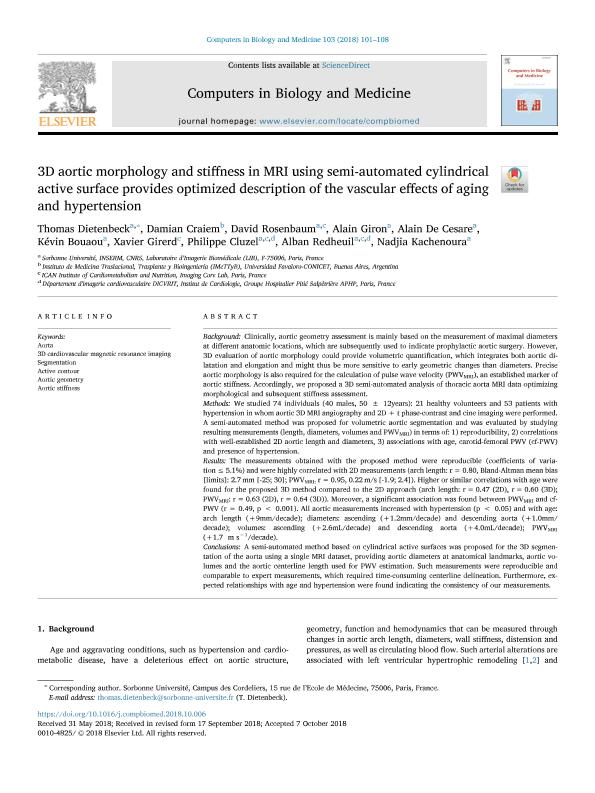Mostrar el registro sencillo del ítem
dc.contributor.author
Dietenbeck, Thomas
dc.contributor.author
Craiem, Damian

dc.contributor.author
Rosenbaum, David
dc.contributor.author
Giron, Alain
dc.contributor.author
De Cesare, Alain
dc.contributor.author
Bouaou, Kévin
dc.contributor.author
Girerd, Xavier
dc.contributor.author
Cluzel, Philippe
dc.contributor.author
Redheuil, Alban
dc.contributor.author
Kachenoura, Nadjia
dc.date.available
2023-05-30T14:10:17Z
dc.date.issued
2018-12
dc.identifier.citation
Dietenbeck, Thomas; Craiem, Damian; Rosenbaum, David; Giron, Alain; De Cesare, Alain; et al.; 3D aortic morphology and stiffness in MRI using semi-automated cylindrical active surface provides optimized description of the vascular effects of aging and hypertension; Pergamon-Elsevier Science Ltd; Computers In Biology And Medicine; 103; 12-2018; 101-108
dc.identifier.issn
0010-4825
dc.identifier.uri
http://hdl.handle.net/11336/198928
dc.description.abstract
Background: Clinically, aortic geometry assessment is mainly based on the measurement of maximal diameters at different anatomic locations, which are subsequently used to indicate prophylactic aortic surgery. However, 3D evaluation of aortic morphology could provide volumetric quantification, which integrates both aortic dilatation and elongation and might thus be more sensitive to early geometric changes than diameters. Precise aortic morphology is also required for the calculation of pulse wave velocity (PWVMRI), an established marker of aortic stiffness. Accordingly, we proposed a 3D semi-automated analysis of thoracic aorta MRI data optimizing morphological and subsequent stiffness assessment. Methods: We studied 74 individuals (40 males, 50 ± 12years): 21 healthy volunteers and 53 patients with hypertension in whom aortic 3D MRI angiography and 2D + t phase-contrast and cine imaging were performed. A semi-automated method was proposed for volumetric aortic segmentation and was evaluated by studying resulting measurements (length, diameters, volumes and PWVMRI) in terms of: 1) reproducibility, 2) correlations with well-established 2D aortic length and diameters, 3) associations with age, carotid-femoral PWV (cf-PWV) and presence of hypertension. Results: The measurements obtained with the proposed method were reproducible (coefficients of variation ≤ 5.1%) and were highly correlated with 2D measurements (arch length: r = 0.80, Bland-Altman mean bias [limits]: 2.7 mm [-25; 30]; PWVMRI: r = 0.95, 0.22 m/s [-1.9; 2.4]). Higher or similar correlations with age were found for the proposed 3D method compared to the 2D approach (arch length: r = 0.47 (2D), r = 0.60 (3D); PWVMRI: r = 0.63 (2D), r = 0.64 (3D)). Moreover, a significant association was found between PWVMRI and cf-PWV (r = 0.49, p < 0.001). All aortic measurements increased with hypertension (p < 0.05) and with age: arch length (+9mm/decade); diameters: ascending (+1.2mm/decade) and descending aorta (+1.0mm/decade); volumes: ascending (+2.6mL/decade) and descending aorta (+4.0mL/decade); PWVMRI (+1.7 m s−1/decade). Conclusions: A semi-automated method based on cylindrical active surfaces was proposed for the 3D segmentation of the aorta using a single MRI dataset, providing aortic diameters at anatomical landmarks, aortic volumes and the aortic centerline length used for PWV estimation. Such measurements were reproducible and comparable to expert measurements, which required time-consuming centerline delineation. Furthermore, expected relationships with age and hypertension were found indicating the consistency of our measurements.
dc.format
application/pdf
dc.language.iso
eng
dc.publisher
Pergamon-Elsevier Science Ltd

dc.rights
info:eu-repo/semantics/openAccess
dc.rights.uri
https://creativecommons.org/licenses/by-nc-sa/2.5/ar/
dc.subject
3D CARDIOVASCULAR MAGNETIC RESONANCE IMAGING
dc.subject
ACTIVE CONTOUR
dc.subject
AORTA
dc.subject
AORTIC GEOMETRY
dc.subject
AORTIC STIFFNESS
dc.subject
SEGMENTATION
dc.subject.classification
Ingeniería Médica

dc.subject.classification
Ingeniería Médica

dc.subject.classification
INGENIERÍAS Y TECNOLOGÍAS

dc.title
3D aortic morphology and stiffness in MRI using semi-automated cylindrical active surface provides optimized description of the vascular effects of aging and hypertension
dc.type
info:eu-repo/semantics/article
dc.type
info:ar-repo/semantics/artículo
dc.type
info:eu-repo/semantics/publishedVersion
dc.date.updated
2022-06-21T19:24:27Z
dc.journal.volume
103
dc.journal.pagination
101-108
dc.journal.pais
Estados Unidos

dc.journal.ciudad
Amsterdam
dc.description.fil
Fil: Dietenbeck, Thomas. Université Pierre et Marie Curie; Francia
dc.description.fil
Fil: Craiem, Damian. Consejo Nacional de Investigaciones Científicas y Técnicas. Oficina de Coordinación Administrativa Houssay. Instituto de Medicina Traslacional, Trasplante y Bioingeniería. Fundación Favaloro. Instituto de Medicina Traslacional, Trasplante y Bioingeniería; Argentina
dc.description.fil
Fil: Rosenbaum, David. Université Pierre et Marie Curie; Francia
dc.description.fil
Fil: Giron, Alain. Université Pierre et Marie Curie; Francia
dc.description.fil
Fil: De Cesare, Alain. Université Pierre et Marie Curie; Francia
dc.description.fil
Fil: Bouaou, Kévin. Université Pierre et Marie Curie; Francia
dc.description.fil
Fil: Girerd, Xavier. Université Pierre et Marie Curie; Francia
dc.description.fil
Fil: Cluzel, Philippe. Université Pierre et Marie Curie; Francia
dc.description.fil
Fil: Redheuil, Alban. Université Pierre et Marie Curie; Francia
dc.description.fil
Fil: Kachenoura, Nadjia. Université Pierre et Marie Curie; Francia
dc.journal.title
Computers In Biology And Medicine

dc.relation.alternativeid
info:eu-repo/semantics/altIdentifier/url/https://linkinghub.elsevier.com/retrieve/pii/S0010482518302993
dc.relation.alternativeid
info:eu-repo/semantics/altIdentifier/doi/http://dx.doi.org/10.1016/j.compbiomed.2018.10.006
Archivos asociados
